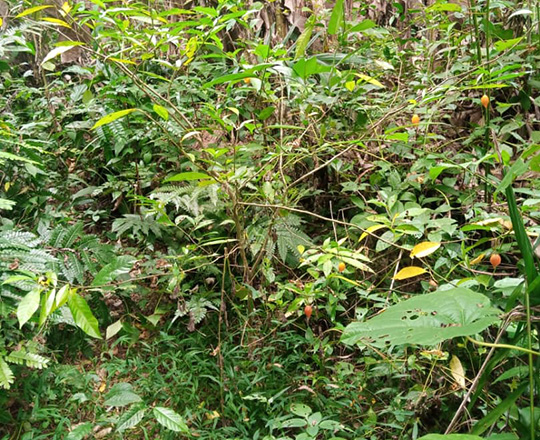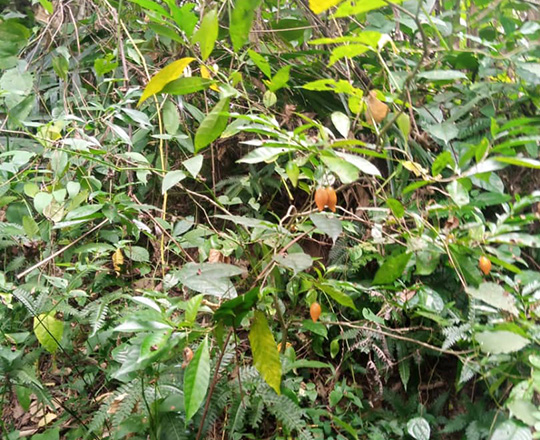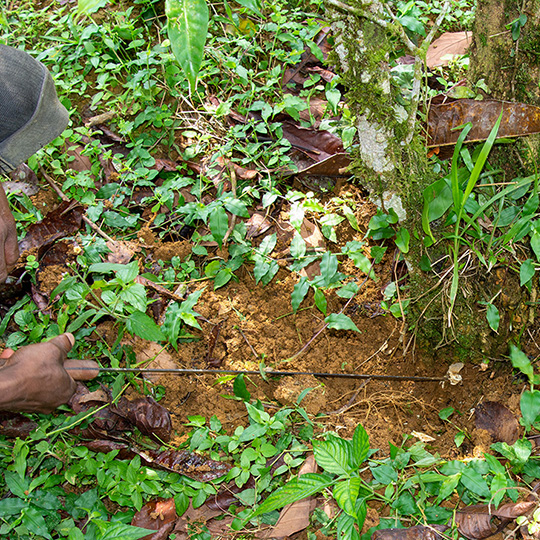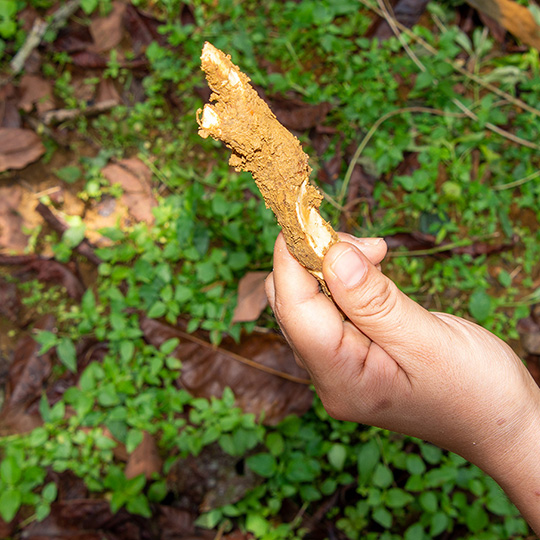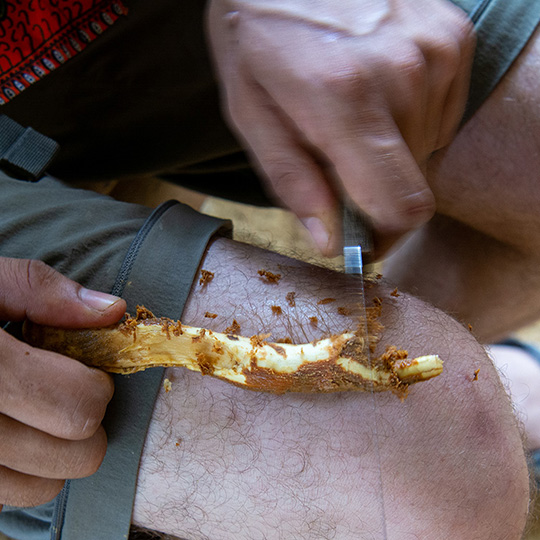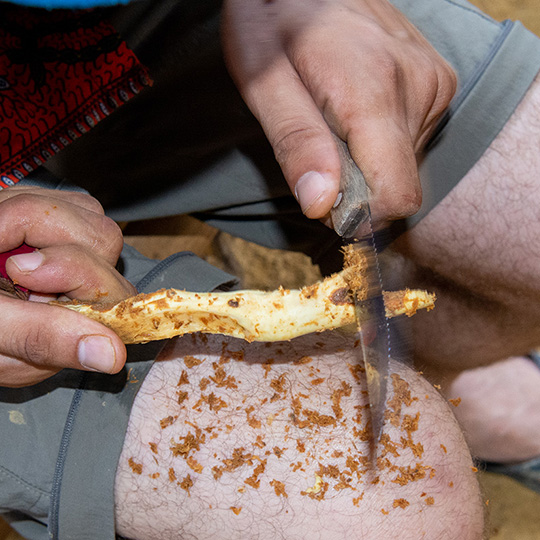Next to the low land gorilla's in Moukalaba-Doudau park is a dissumba tribe that are celebrating their Bwiti initiations
About Iboga
Iboga, officially called Tabernanthe iboga (also known as Black bugbane - Le bois sacré), is a rainforest shrub indigenous to Gabon and Cameroon, capable of growing up to 10 meters tall. It is known around the world as the grandfather of all plant medicines.
It contains a non-addictive alkaloid called ibogaine that can produce healing miracles on a physical, mental, and spiritual plane when consumed.
Most of the ibogaine is located in the cambium layer (outer layer) of the iboga roots, especially in the older iboga shrubs.
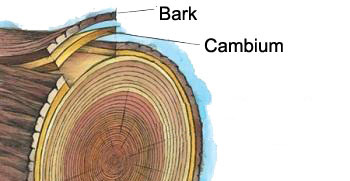
cambium layer
Ibogaine is the primary alkaloid present in the iboga root and accounts for about 80% of the alkaloid profile. In addition to ibogaine, the root bark also contains alkaloids such as ibogaline, ibogamine, tabernanthine, voacangine, harmaline, and noribogaine. Each of the alkaloids possesses unique features yielding pharmacological benefits and seems to work in synergy with ibogaine.
When it was originally found by the Babongo Pygmy tribes, it was used as a rite of passage for the youngsters transitioning into adulthood. This ritual cleared them from most of their traumas and dramas in life and released them from their ego prison. In time, this grew into a new religion called the Bwiti.
Dissumba dance
But the Bwiti religion is unique in that it does not have any scriptures or books written about how iboga works. It only passes along information on how to set up a ceremony correctly. This is normally passed on from one generation to the next. Bwiti is also a bit secretive due to the Christian suppression in the past.
But we live in a modern world, and the suppression has become a lot less, and with the internet connecting all the different spiritual movements around, this makes it possible to actually explain what iboga does in familiar terminology.
What does iboga do?
It wakes up and develops the Kundalini.
Now Kundalini is an Indian term not often used in Gabon, but this explains exactly what iboga does.
It does this so effectively that no other tool nor method on the planet comes even close to what one full iboga ceremony can accomplish.
There is a whole page dedicated to explaining what the Kundalini is, but in a nutshell, it is like the fire of a candle that burns and dissolves all karma like the burning of all the wax of the candle until all is empty, which is referred to as the Nima state in Gabon or full self-realization in India.
In combination with the right meditation and music, iboga is considered the most powerful tool for awakening the Kundalini and bringing forth the state of full self-realization and beyond.
Among the Bwiti practitioners, it is not common to see iboga being combined with meditation techniques. However, looking at the different Buddhistic and Hinduistic techniques that work directly with the Kundalini, it is easily shown how effective these two work together. This is something Mama Aline is interested in, to make the healing process as effective as possible. Basically, using the most effective tools on the planet and combining them into one package.
But this is still a project that is in the making. This website shows what meditation techniques work best with iboga, but our ceremonies are still rooted in the original structure of the Bwiti initiations. So at the moment, it is more of an extra tool you can use during the initiation and during microdosing to speed up the process of clearing traumas and dramas (karma). But in the future, this will develop into a more united approach of Bwiti and Dzogchen Buddhism.

Keith Dowman
Dzogchen teacher Keith Dowman uses this approach and has commented on the potential of iboga to facilitate moments of deep insight into the nature of mind. However, he cautions against becoming too engrossed in the psychedelic experiences, emphasizing the importance of not letting them detract from the deeper spiritual insights. In other words, using the right meditation tools alongside iboga makes this path the most effective path. Another way to look at this is to ask yourself the question: how many enlightened masters have come from Gabon, compared to Tibet? Hence the need to combine these two methods.
What does iboga do on a physical level
Iboga is unique in that it not only fosters new connections but is also one of the few known substances that can actually stimulate the creation of new brain cells, particularly in the dopamine center of the brain. It facilitates a comprehensive rewiring of the brain, leading to a stable Nima (enlightened) state. This herb also has a profound effect on the pineal gland, where it decalcifies the gland and rejuvenates the body as a result. It also has the ability to reverse epigenetic markers of aging and has a strong effect on one's libido, returning it to a more youthful state. Basically the iboga transforms you from a catterpillar into a butterfly - see youtube below. All in all, an amazing plant.
Ibogaine influence on gene expression - Roman Paskulin
It might be a bit technical, but this studty is really amazing and interesting. This is also the reason why people after an iboga ceremony are much more sensitive to coffee or NAD+ / NMN / Nootropics, anti-oxidents or any other energy supplement or product. These supplements are not needed anymore after iboga, because iboga goes to the root of the problem and solves it.
Ibogaine is considered a nootropic itself. A nootropic is a substance that enhances cognitive function, particularly executive functions, memory, creativity, or motivation, in healthy individuals.
Distinct from Ayahuasca or San Pedro, which interact with a single neurotransmitter, iboga engages with five main neurotransmitters: NMDA, nicotinic, σ-, κ-opioid, and μ-receptors, maintaining this connection for weeks to months. This is another reason why iboga is so effective, as the process keeps on working for months in a row. Also, once the Kundalini is fully activated, there is no easy way to stop this process, so you are put on a spiritual journey of self-healing until fully stable in the Nima state.
The best way to consume iboga is fresh and not dried or in purified forms like PTA. The reason is simple: the fresh iboga numbs the taste buds so it is easier to consume and it is faster in absorption rate, so the process will be deeper and not as long as with the dried powder. Plus fresh ibogo contains all the other alkaloids helping with the process.

Mama Aline serving fresh iboga - with honey :)
The purified forms are often used in drug rehabilitation centers such as those found in Mexico. Many of the accompanying alkaloids in fresh iboga are missing in these treatments, making it less spiritual. Fresh iboga is also considered the original way of consuming iboga during the Babongo Pygmy tribe initiations, but because iboga becomes more difficult to find these days, people have to go deep into the Gabonese jungle to locate them. Because of the time it takes from harvesting to bringing them to the Bwiti villages, many have turned to dried iboga as this is much easier to preserve. But at Mama Alines village, the iboga is growing in jungle that belongs to the village, so it is always fresh.
Mama Aline harvesting fresh iboga in her own jungle.
But using iboga is not without risk. People who are suffering from heart problems, especially those related to QT intervals and/or having liver problems should stay away from iboga. Also, those suffering from diabetes or having a very weak body should stay away from iboga. Iboga is very demanding and you should physically be in good shape.
Also, those who are dependent on pharmaceutical drugs should avoid iboga or use it under professional supervision like a doctor or a specific ibogaine clinic. This also counts for those who are street drug dependent.
Microdosing is a good approach for those considering going solo or want to experience iboga before taking the big step into Gabon. If you consider this path, be sure to play some Bwiti music as this not only helps you attune to the iboga energies, but also keeps you in the alpha brain waves for optimum healing.
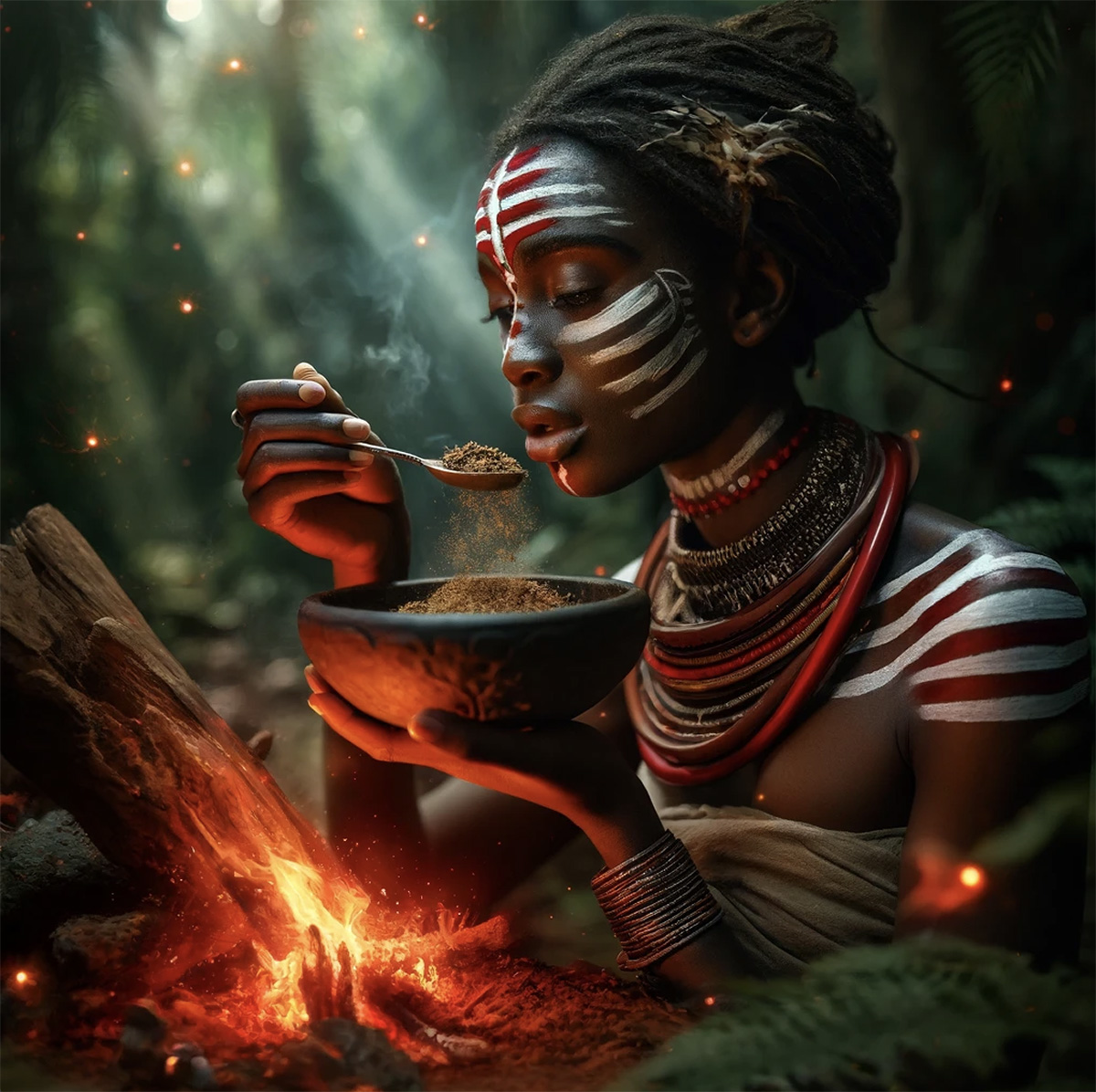
Microdosing iboga
This brings me to the part of how much iboga is used during a ceremony and how much you can take when microdosing. This is not easy to answer for the simple reason that the potency of iboga differs incredibly between one supplier and another.
As said before, the older the iboga, the more potent iboga becomes. But also, the location where iboga is harvested plays a major role.
General rule is that the slower iboga grows, the more potent it becomes, hence the Seta Camma iboga is
one of the best, because it grows really slowly. But iboga that is too old is also not good because it is too bitter, making it very difficult to eat without throwing up.
In other words, it is not easy to find good quality iboga and especially good quality fresh iboga.
At mama Alines ceremonies she gives about 8 spoons per person of freshly harvested 20 year old iboga. The dissumba initiation and Niembe initiation she gives a lot more.
Now some people ask the question: why not make capsules ? It seems iboga is not as effective in capsule form and degrades the process by about half. Most likely saliva is needed to make iboga work best.
In Gabon, iboga is held so sacred that in the year 2000, the Council of Ministers of the Republic of Gabon declared Tabernanthe Iboga a National Treasure and prohibited the export of it as it was uprooted in a pace that was unsustainable.
So be aware that most of the iboga online does not originate from Gabon, but elsewhere and that most of the iboga sold online does not approach the same quality and potency of iboga available in Gabon.
Is an iboga initiation only once in a lifetime?
For most living in Gabon, an iboga ceremony is only done once in a lifetime. However those who want to become Nimas (shamans) take more ceremonies, often different types of initiations. After experiencing an iboga ceremony, it's recommended to wait at least six months before participating in another, to avoid overloading the system and potentially end up in a Kundalini crisis.
Microdosing on the other hand can be done in the following sequence: 2 days 1 gram each and 1 day rest. Obviously, it depends on the quality of iboga how many grams you should take, but generally 1 gram is a good microdosing quantity.
For those exploring nootropics post-ceremony, caution is advised due to increased sensitivity to substances like neuro-mag, J147, centrophenoxine and even coffee, which could overstimulate the Kundalini. Sleep disturbances post-ceremony are common, but can be alleviated with magnesium and CBD oil, and liver support can be provided through supplements like milk thistle.
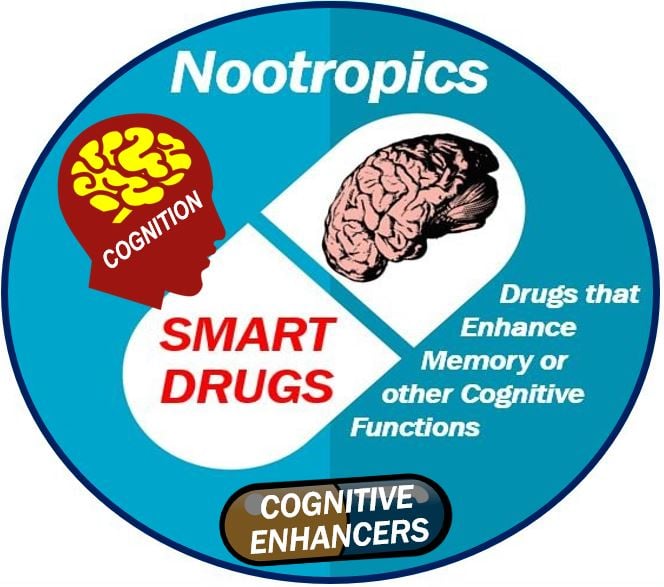
Nootropics
Diet Before & After Iboga
While there's no strict "Iboga Diet," a mindful approach to eating can significantly enhance your experience. But even alcohol is consumed in Gabon during the rebirth celebration (not the Nima or participants obviously) The connection between body, mind, and soul is profound, and a conscientious diet often reflects in our thoughts, environment, and social interactions. Post-experience, many find a natural inclination towards dietary improvements, mirroring internal shifts. Having said that, do expect meat in the diet when you are in Gabon.
- Prioritize healthy, vibrant foods, incorporating organic and minimally processed options.
- Include pastured, wild meats, and seafood, or embrace hearty plant-based alternatives.
- Emphasize fruits, vegetables, and grounding foods, such as root vegetables and bone broths.
- Minimize sugar intake and eliminate alcohol and caffeinated beverages to manageable levels. Also avoid gluten a week prior to arriving in Gabon.
- Focus on hydration, aiming for significant daily water intake and avoiding processed foods and beverages.
- After the initiation, make sure you keep your sugar intake very low and avoid gluten where possible. Iboga reduces not only the bad but also some good intestinal bacteria.
In summary, iboga offers a profound spiritual and therapeutic potential, but its use requires careful consideration, preparation, and respect for its power and risks.



